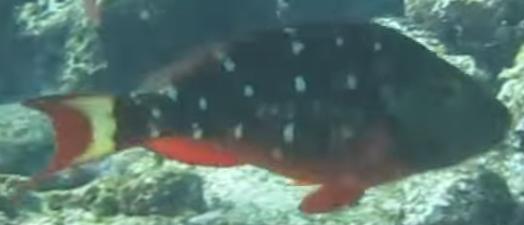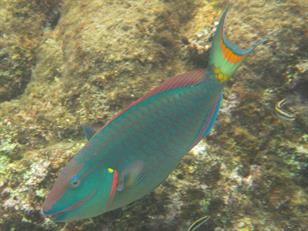



Sparisoma viride
| Ecological Descriptors |
||||
| Habitat | Size (cm) | Diet | Behaviour | Sex |
| Co, R | 65 | Veg, Cor | I, Ter (Sh) | F/ PGH |
General:
Parrotfish owe their name to the shape of their mouth. Instead of teeth they have two beak-like plates, like parrots. They have even rows of large, noticeable scales on their bodies. The development of parrotfishes is complex and accompanied by a series of changes in color (polychromatism). Individuals usually mature as females (Initial Phase), with some later changing to the males (Terminal Phase). The Stoplight Parrotfish is one of those slightly unusual in this respect (see below)
Description:
Terminal phase: Body emerald green with a bright yellow spot at the upper corner of the gill cover, a yellow area at the base of the tail and a salmon to yellow crescent on the tail. The female usually has red-brown upper parts with a red belly and conspicuous white dots on the body.
Initial phase: Upper body and head mottled reddish brown, mixed with white scales and a crescent on the tail. Belly and tail red.
Juvenile phase: Body dark reddish brown with three rows of widely spaced white spots. Belly lighter and a white bar on the tail. Almost indistinguisable visually from Redtail and Yellowtail Parrotfishes.
Ecology
They swim about reefs using their pectoral fins; the tail is only used for burst of speed. They use their 'beaks' to scrape algae and polyps from corals and rocks. They are often seen defecating, what looks like white clouds, which consists mainly of coral limestone. Common to 49 m depth
Life Cycle:
The Stoplight Parrotfish differs from most other Parrotfish, in that many individuals develop directly into males. The younger and not so colorful males fertilize together with other males the eggs of one single female, while colorful, large males have each their own territory where one male fertilizes one female. Lives for at least 9 years.
Spawning occurs year round, usually at dawn in deeper reef areas, peaking in the summer time. Secondary males pair with one female and defend a territory, while primary males form a small group to mate with females away from territories. This type of spawning is called aggregated spawning where an individual may rush upward to release either sperm or eggs at the peak of these upward dashes. After reproduction the fish return to their natural habitat. The eggs are 1mm in diameter, buoyant and spherical and after 25 hours larvae are released.
Parrotfish owe their name to the shape of their mouth. Instead of teeth they have two beak-like plates, like parrots. They have even rows of large, noticeable scales on their bodies. The development of parrotfishes is complex and accompanied by a series of changes in color (polychromatism). Individuals usually mature as females (Initial Phase), with some later changing to the males (Terminal Phase). The Stoplight Parrotfish is one of those slightly unusual in this respect (see below)
Description:
Terminal phase: Body emerald green with a bright yellow spot at the upper corner of the gill cover, a yellow area at the base of the tail and a salmon to yellow crescent on the tail. The female usually has red-brown upper parts with a red belly and conspicuous white dots on the body.
Initial phase: Upper body and head mottled reddish brown, mixed with white scales and a crescent on the tail. Belly and tail red.
Juvenile phase: Body dark reddish brown with three rows of widely spaced white spots. Belly lighter and a white bar on the tail. Almost indistinguisable visually from Redtail and Yellowtail Parrotfishes.
Ecology
They swim about reefs using their pectoral fins; the tail is only used for burst of speed. They use their 'beaks' to scrape algae and polyps from corals and rocks. They are often seen defecating, what looks like white clouds, which consists mainly of coral limestone. Common to 49 m depth
Life Cycle:
The Stoplight Parrotfish differs from most other Parrotfish, in that many individuals develop directly into males. The younger and not so colorful males fertilize together with other males the eggs of one single female, while colorful, large males have each their own territory where one male fertilizes one female. Lives for at least 9 years.
Spawning occurs year round, usually at dawn in deeper reef areas, peaking in the summer time. Secondary males pair with one female and defend a territory, while primary males form a small group to mate with females away from territories. This type of spawning is called aggregated spawning where an individual may rush upward to release either sperm or eggs at the peak of these upward dashes. After reproduction the fish return to their natural habitat. The eggs are 1mm in diameter, buoyant and spherical and after 25 hours larvae are released.
Stoplight Parrotfish
TP
TP

Stoplight Parrotfish Juvenile
Stoplight Parrotfish IP
Stoplight Parrotfish IP
Stoplight Parrotfish TP

(C) Adona9






68

152




153

67
Stoplight Parrotfish Juvenile


